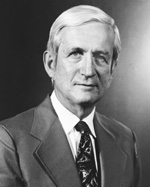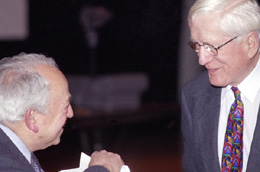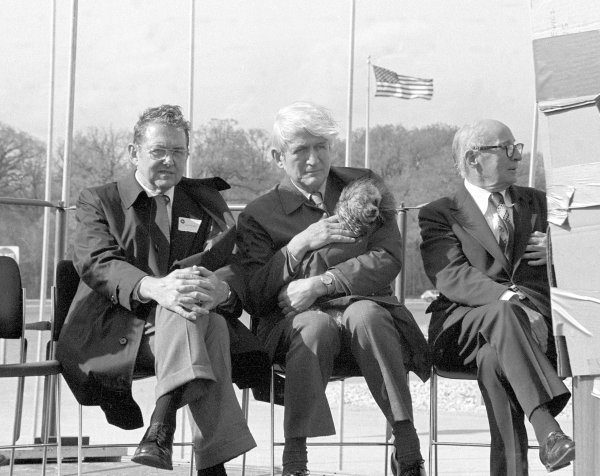 |
|
First-Hand Account
by Mike Perricone
Norman Ramsey has seen too much history to risk predicting the future, especially for the intervening weeks until his Feb.26 Fermilab Colloquium presentation on “Scientists in Times of War.” “The circumstances surrounding my giving the talk may be rather different by then,” he said, as February opened with tensions unresolved over weapons inspections in Iraq. Whatever the circumstances,the talk will not be an academic exercise for Ramsey. Before chairing the advisory committee that recommended establishing a national accelerator laboratory; before serving as the first president of Universities Research Association,Inc., the consortium contracted to run the laboratory;before having Fermilab’s Ramsey Auditorium named for him; before winning the 1989 Nobel Prize in physics for developing the maser, used in atomic clocks; before launching his decades-long search for an electric dipole moment in the neutron... That’s a lot of history right there,but even earlier than all those achievements, Norman Ramsey played a significant role in history when the world was at war and scientists were needed to develop weapons and defenses. Before the U.S. formally entered World War II, Ramsey headed the group developing three-centimeter radar at the MIT Radiation Laboratory —and radar was regarded as the decisive factor for the Royal Air Force in the Battle of Britain. Ramsey joined the Manhattan Project in 1943 and served as Head of the Delivery Group at Los Alamos when the first atomic bomb was built and tested.
“In World War II, it was clear who were the good guys and who were the bad guys,” Ramsey, now 87, said from his home in Boston.“I think there’s rarely been a war for which the distinctions were so clear — who started it, what aggressions preceded it. This is a moral help to scientists or anyone else in a war, because there are so many terrible aspects. It’s worth spending a great deal of effort on that moral distinction. One of the worries in the present situation may be that it [the moral distinction] is not quite so clear. It poses a dilemma in a certain sense.The problem is not that the applications of science aren’t effective.On the contrary, they are very effective. That means killing a lot of people. That’s very difficult to have on your conscience,at the time and subsequently.” In his talk, Ramsey will touch on the play,“Copenhagen,” and the book,“Tuxedo Park,” both achieving popularity with their themes of science and scientists in times of war. “Copenhagen” explores the relationship between atomic scientists Niels Bohr and Werner Heisenberg,and the issue of whether Heisenberg helped or hindered the atomic bomb program of Nazi Germany. “I knew Heisenberg only slightly, but I knew Bohr well,” Ramsey said.“Bohr was a very fine person.” And then there’s the story of shadowy financier and amateur scientist Alfred Lee Loomis,who helped establish the MIT laboratory,built his own science enclave in Tuxedo Park,New York,then applied his wealth and political connections to nudging the U.S.effort to build the first atomic bomb. “I think the book exaggerates his technical expertise,” Ramsey said,“but he did a lot to get the [radar] project moving rapidly through the government.He also did a lot to get nuclear weapons work going.He had very strong judgment, he was very vigorous in pushing things,and he had money.He had a lot of money.Those were the days before rental cars,and in every city he went to,he had a limousine and a driver.” Ramsey has also done his share of moving projects along.He was instrumental in founding Brookhaven National Laboratory,headed the physics department at Harvard University,and in 1962 was tapped to chair a committee to formulate recommendations on the future of U.S.high-energy physics over the next decade. The report of his group,and of a subsequent design committee from Berkeley Lab,pointed the way to establishing a national accelerator laboratory operated by a consortium of universities. The original group of 30 universities formed a board of scientists and non-scientists,then formed a smaller board that could work more effectively — the smaller group including Ramsey and Robert Rathbun Wilson of Cornell University. “The board of trustees was mainly worried about the selection of a director,and was compiling a list during the site selection process,”Ramsey recalled.“When the Illinois site was finally selected, the Berkeley people were very disappointed,and one of their guys turned it down.Bob Wilson was on the board,but he was regarded as ineligible. He was finishing up the Cornell accelerator lab, and the trustees felt that if he abandoned that project,he wasn ’t responsible enough to be a good director.Well,typical of Bob Wilson,he finished the Cornell project a year ahead of schedule.So he was available.I was chosen as the first president of URA,and Bob and I worked very well together.” Ramsey continues to work at Harvard,on the goal he has pursued for more than four decades: finding an electric dipole moment in the neutron. “It’s still a very open and fundamental question,” he said.“I’m 87 years old, but I’m not giving up.”
ON THE WEB:
|


